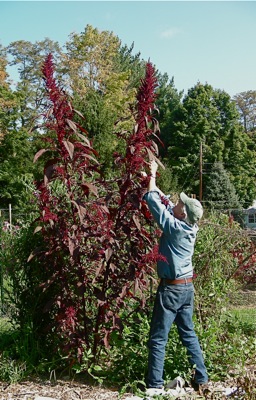For Giant Red Amaranth, Take the Direct Route
In Part 1 of the fall planting series, I seem to have neglected to mention that many of the herbs and flowers that can be left to plant their own seeds should be grown directly from seed no matter who does the planting, so letting them do the job themselves is not only easy but wise.
Giant red amaranth, for instance, is very easy to transplant. It has such a great will to live that unwanted seedlings ripped out and thrown aside will pick up their heads and forge onward with no help at all. But transplants never achieve the great heights that make this thing such a head-turner. Even when coddled they seldom get more than about 4 feet tall, whereas plants that have never been disturbed…

Bill showing you that the Giant Red Amaranth is about 9 feet tall right now. I can't show you the hedge of it in the other garden because he cut it down so it wouldn't shade the chrysanthemums and broccoli raab.















It would be appreciated if you told me how can i find the the seeds of some giant amaranth geotypes. Actually when I was conducted my Ph.D thesis in the majoer of corn-redroot pigweed ( Amaranthus retroflexus) competition, I find that C4 photosynthetic pathways of these spesies would be useful fo increasing dry matter accumulation during long and hot summers of my home country. So I have started to research more abouth Amaranth species. Now I have planted 2 genotypes that I suppose one of them could be the red amaranth. I can the pictures of our current fields in Tehran (22 sept. 2009. Anyways I would like to develope our knowledge in this regard. As you know starting a project to introduce a new crop, first of all need to a valid and available source for obtaininf the seeds.
Lokking forward to hear from you regarding to my request .
Regards
Majd Aghaalikhani
Majid,
I’m afraid I’m not much of an amaranth expert, but I do know who can probably help you – Native Seeds SEARCH.
SEARCH stands for Southwestern Endangered Aridland Resource Clearing House, and the organization is very active in research on and preservation of historic (and deeply historic) vegetable crops. Their retail branch offers a wide variety of amaranth seeds, and they’re also well connected to the academic world, so I’d start with them. If they can’t help you themselves they probably know who can.
good luck!!